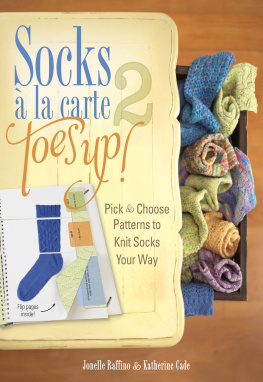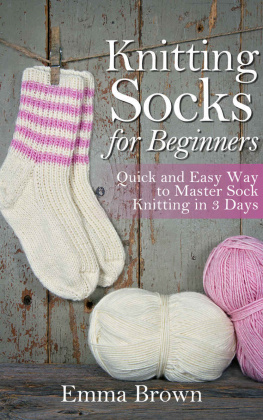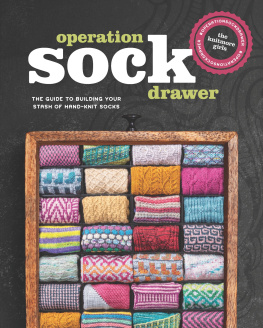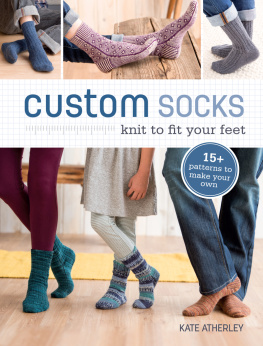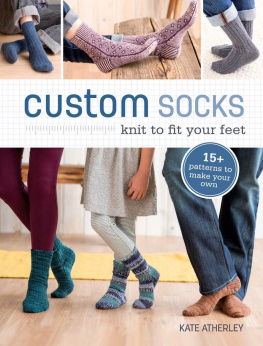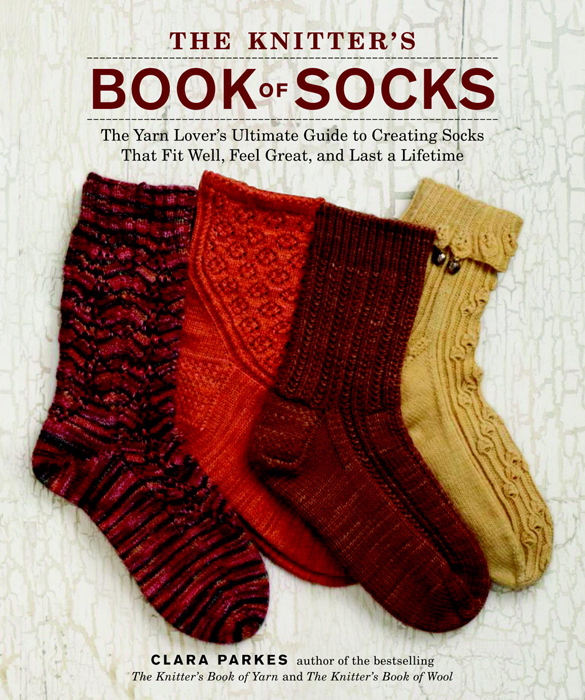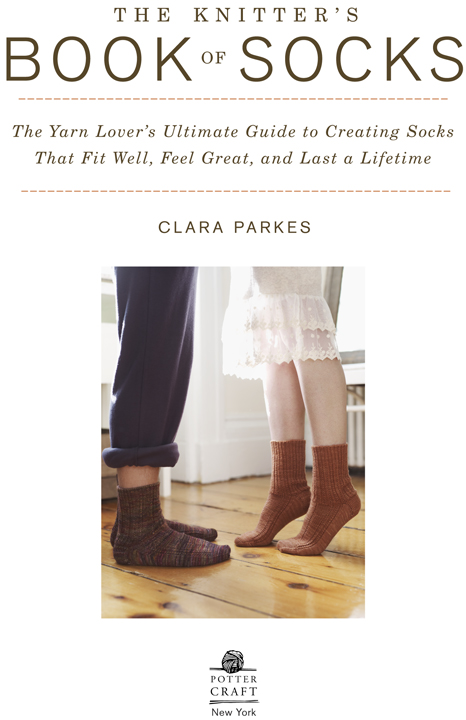Copyright 2011 by Clara Parkes
Photography 2011 Alexandra Grablewski
Cover by Jenny Kraemer
Front cover photography by Alexandra Grablewski
Illustrations by Kate McKeon
All rights reserved.
Published in the United States by Potter Craft, an imprint of the Crown Publishing Group, a division of Random House, Inc., New York
www.crownpublishing.com
www.pottercraft.com
POTTER CRAFT and colophon is a registered trademark of Random House, Inc.
Library of Congress Cataloging-in-Publication Data
Parkes, Clara.
The knitters book of socks : the yarn lovers ultimate guide to creating socks that fit well, feel great, and last a lifetime / Clara Parkes.
p. cm.
eISBN: 978-0-307-58681-0
1. KnittingPatterns. 2. Socks. I. Title.
TT825.P363 2011
746.432dc22
2011002682
v3.1

Introduction
Socks are the breakfast of our knitting diet, a physical and metaphorical underpinning to our day. They get us off to a good start, send us out into the world, and give a good indication of how the day will go. Is the cuff too tight? Frustration and discomfort from the get-go. Fabric wont breathe? A stifled day. Has the foot sprouted a hole? Or two? A sense of sloppiness prevailsalong with a fear that youll have to remove your shoes and expose your secret to the world.
But when fiber, twist, ply, stitch, and foot unite in a wholesome, well-balanced nutritious breakfast, the day is yours. You are proud, comfortable, confident. Why, yes, you quickly answer, hoisting up your pant leg and slipping off your shoe for a better view, I did knit them myself. Arent they fabulous?
I want you to feel this triumphant every day, which is why Ive created this book about the art, science, and sheer pleasure of knitting socks from the yarn up. Many excellent sock-knitting books already exist, each offering gorgeous design ideas and ingenious techniques. But none of those books approaches socks exclusively from a yarn perspective. Without that information, a vital part of the sock equation remains a giant question mark.
Sure, you can knit socks out of just about anything, from dental floss to bailing twine and even licorice, just as you can make a stunning teakettle out of papier-mch. As long as you never actually tried to use these items for their intended purposes, theyd be beautiful. But once we add functionality to the equation, our choices narrow.
Having ruled out bailing twine, the next logical step is to use a yarn that looks pretty and feels nice. But theres still much more to it.
If youve knit socks for any length of time, you may have already encountered one or two sock failures. Sometimes the pattern was to blame, sometimes the knitter. But more often than not, the problem was with the yarnnot elastic enough for certain stitches, too splitty for the needles you chose, or perhaps it blew a hole after just a few wearings. All easily avoidable, and youll learn how.
I should note that so-called sock yarns can be used for all sorts of other projects, too, everything from shawls and blankets to sweaters and baby clothes. But this book focuses literally and exclusively on sock yarns as they are used for socks. It picks up where The Knitters Book of Yarn left off, taking you deep into the complex and challenging structural universe of socks.
No other knitted garment experiences wearability demands as arduous as the humble sock. Hats and sweaters, shawls and scarves have it easy. Only socks must defy gravity and stay upright on our legs, cling to our calves without cutting off our circulation, hold tight to a foot thats jammed into an increasingly hot, humid shoeand then endure being trampled on for countless hours while still remaining pretty to the eye. The well-conceived, well-constructed, handknitted sock will survive this endurance challenge with flying colors. It is a work of beauty.
HOW TO USE THIS BOOK
This book follows the sock-yarn life cycle from its early days as a pile of fluff to its final moments on a proud foot. Well look at how common fibers may meet the demands of a sock, how a yarns construction can further meet those demands, and how you can manipulate your stitches to coax even the most reluctant sock yarn into submission. Youll learn how to pair fiber, twist, ply, pattern, and even stitch for a happy sock, and how to modify sock patterns when necessary to better accommodate a specific yarn. By the end of this book, youll be reading labels and squeezing skeins to get a better idea of what sock yarns can doand youll know how to compensate for what they cant. I want you to love every pair of socks you knit, and this book will help you do just that.
As always, I believe we learn best by doing, which is why I asked some of my favorite sock mentors to pitch in. Together, weve created twenty sock patterns that explore themes of fiber, durability, and wearability from different stylistic angles that include lace, ribbing, cables, and colorwork. Even the designers were often surprised by what they discovered and ultimately created when conceiving socks from the yarn up.
Once youve grown familiar with all the necessary components of a successful sock, youll be able to play with them, like interchangeable building blocks, confidently making adjustments in fiber, yarn, and stitch to concoct the ideal socks for your needs.
Of course, you could also launch right into the patternsthe knitters version of salting your food before tasting it. In life and in knitting, any experience is broadened by knowledge. My hope is that youll spend a little time up front reading more about the why and how of what youre doing before you cast on. Id like you to understand what makes these socks work, and how you can put together your own nutritious breakfast from now on.
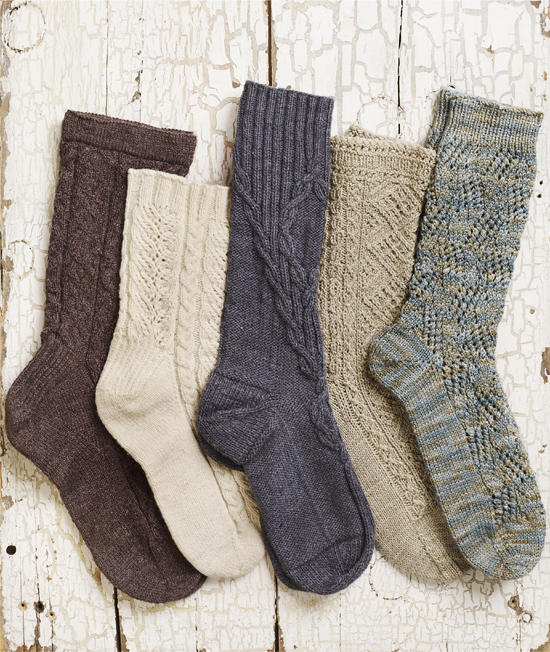
Chapter 1
What a Sock Needs
Elasticity, strength, and absorption. Those three qualities dictate everything. An unhappy socks demise can almost always be traced back to a deficiency in one of these areas, while a happy sock always has a healthy dose of all three qualities. Elasticity, strength, and absorption dictate both the knitting and wearing experience equally. Remember them, because they are the foundation of everything well explore in this book.
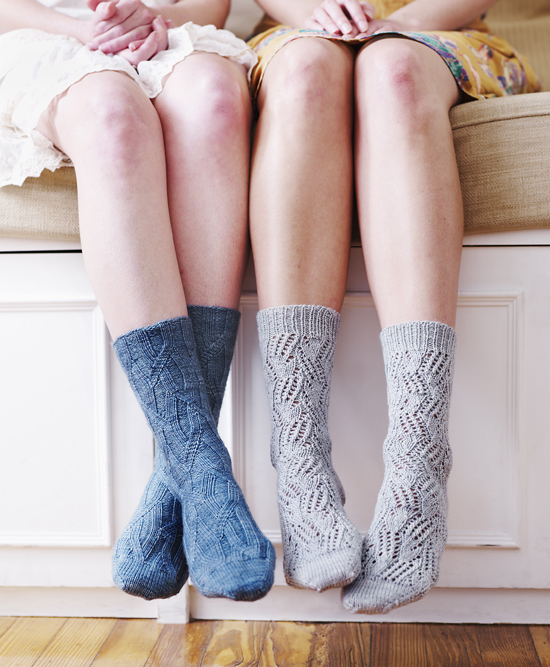
Lasting Elasticity
Hats have the luxury of resting on our heads, and sweaters enjoy the support of our shoulders and arms. Shawls can drape on our shoulders, and even knitted skirts have a natural shelf created by our waists. But socks must perform gravity-defying miracles. Starting at our toes, they enclose our foot, make a sharp turn at the heel, and then work their way up our leg. Just when things are starting to get good, we ask our socks to stop and sit there in midair, with no natural support whatsoever. Some kneesocks benefit from a natural shelf at the top of the calf, but the majority of socks have nothing.


